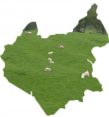Sproxton is a village in the borough of Melton in Leicestershire, close to the border with Lincolnshire. Methodists were the most prominent nonconformist denomination in the village, with both Wesleyan and Primitive Methodists present.
Wesleyan Methodists
Wesleyan Methodists erected their first purpose-built chapel in 1809, with a capacity of 200.[1] Actual numbers of worshippers were significantly fewer, with 37 people present at the morning service and 48 at the evening service on the day of the religious census of 1851. The average figure noted was slightly higher, at 50 for both morning and evening services. The census also noted the presence of a Wesleyan Sunday School, with 23 in attendance.[2]
This chapel was replaced by a new chapel, which opened on 14th August 1865.[3] The Grantham Journal described this new chapel as ‘a beautiful gothic structure’, erected at a cost of more than £50. The chapel attracted a ‘large’ congregation, although the Journal does not give any precise figures.[4] A key benefactor in the development of the Wesleyan church was Mr John Coy, whose family came from the village. He supported the Wesleyan Church through donations, in particular (but not exclusively) in 1882, when he gave the church a donation of approximately £400, which was used to pay off the church debt and build a new school room.[5]
In 1995 the building, no longer used by a congregation in Sproxton, was shipped to the USA, where it was rebuilt stone-by-stone to become the Clarice L. Osborne Memorial Chapel at Baker University in Baldwin City, Kansas
Primitive Methodists
Primitive Methodists were likely to have become settled in the village in the 1830s, and records note that their settlement in the village was met with opposition. An incident was recorded in the Stamford Mercury in August 1839 that a camp meeting of Primitive Methodists from the Melton Mowbray circuit was disrupted by ‘some persons from Sproxton’, who threw ‘offensive missiles’ at the preachers from behind bushes.[6] The Leicestershire Mercury also reported, in 1841, that the chapel that was currently under construction would be closer to completion if ‘the Curate of Sproxton had attended to his own Pastoral duties, instead of secretly interfering with, and opposing the cause of Primitive Methodism.’[7]
There is evidence that Primitive Methodists were numerous in the village at that time. In April 1841, in preparation for the new chapel, a female preacher held a sermon that ‘was numerously attended’ – although, again, exact numbers are not specified. This was also the day on which the land was purchased to build the chapel.[8] However, this chapel, once built, disappears from the records very early after 1841. Its existence is noted in a trade directory in 1846, and again in 1861 – but neither of these are confirmed by any of the other directories.[9] It is possible that Primitive Methodists did remain in the village, meeting in a house rather than a chapel, although there are no sources to confirm this.
Return to Protestant Nonconformity: A-Z
[1] Religious census, 1851, entry for Sproxton HO 129/418/98.
[2] Ibid.
[3] White, Hist. Gaz. & Dir. Leics. (Sheffield, 1877), p. 602; Grantham Journal, 18th February 1865, p. 2.
[4] Grantham Journal, 18th February 1865, p. 2.
[5] Grantham Journal, 1st April 1882, p. 8
[6] Stamford Mercury 30th August 1839.
[7] Leicestershire Mercury, 17th April 1841, p. 3
[8] Stamford Mercury 9th April 1841.
[9] White, Hist. Gaz. & Dir. Leics. (Sheffield, 1846), p. 259-60; Drake, Gaz. & Dir. Of Leics & Rutland (1861), p. 304.
